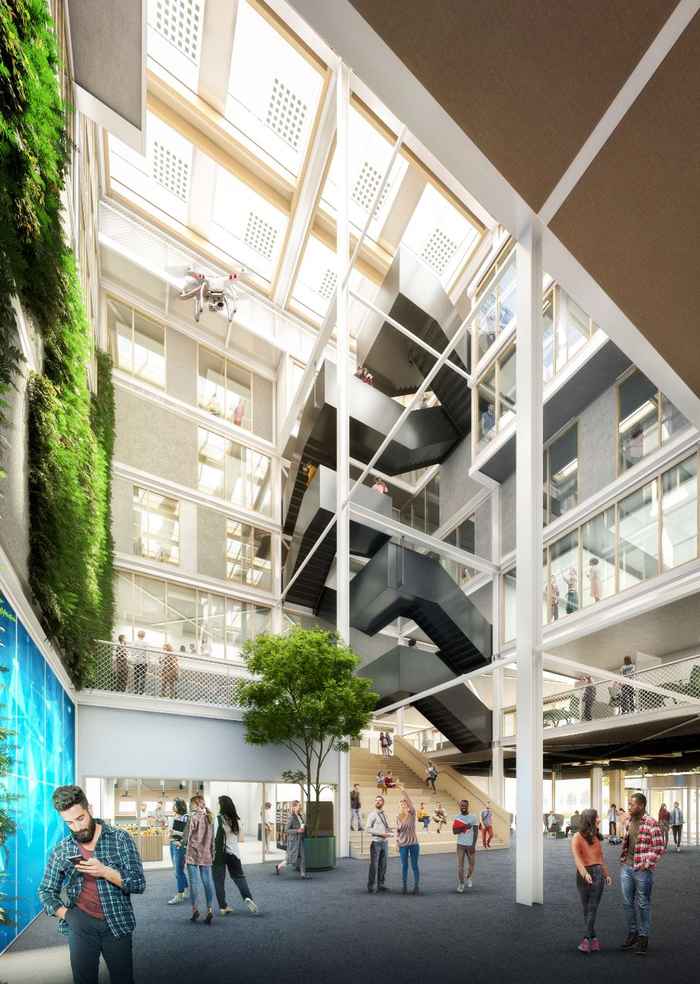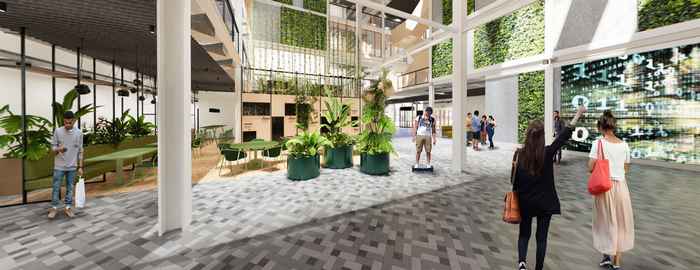Design and impression

On 31 October, the Executive Board of the UvA definitively awarded the construction of the new building at Amsterdam Science Park to Benthem Crouwel Architects. The architects presented a soundly based design vision which also offers enough freedom for creating a building that will tie in with the goals of the University of Amsterdam and the various building users.
When selecting the architects and consultants (the Design Team), the UvA was required to follow the European procurement rules. On the basis of the vision, action plan, building company and circularity, in combination with the costs, Benthem Crouwel Architects then proved to be the unanimous choice from the proposals submitted.
Studio Groen+Schild is responsible for the interior design. The design team also comprises the construction consultancy firm Strackee Bouwadviesbureau, the building installation services consultancy firm Deerns and the building physics consultancy firm DGMR.
Atmosphere and theme
The overarching interior theme in the design is tech & nature. Tech represents our degree programmes and institutions, and we opted for nature because greenery is a universal need and contributes to a healthy and pleasant work environment.
The look and feel we are aiming to create is fresh, light and warm. The building has plenty of daylight that, in combination with greenery, ensures a pleasant building in which everyone enjoys spending time. At the same time, the use of colour and materials create a warm ambience. The variety of spaces and ambiences ensure that the building’s various zones are clearly recognisable. The building is practical and multifunctional in its use and the design and interior are tailored to this.
-
Foyer

LAB42 foyer by Studio Groen+Schild On the ground floor, you will first encounter the foyer. The foyer invites people to come into the building. It's a space with lots of natural light from which you can look into the building. Here, you will find the large open atrium and student rooms where users can meet.
-
Teaching rooms and study places
Impression of LAB42 study places by Studio Groen+Schild The teaching rooms, lecture rooms and study places are located on the first and second floors. The teaching rooms are flexible and multifunctional. All the rooms have sufficient daylight, which contributes to a healthy learning environment. The design encourages activity and is colourful. The layout and furnishings enable active learning.
Although the study places differ in terms of atmosphere, appearance and experience, they clearly convey the function for which they are intended. A high-intensity study space creates an atmosphere in which it is clear from the outset that silence is required. All spaces must be comfortable and have a power socket.
‘The indoor greenery provides positive associations with well-being, health, relaxation and an optimal environment for work and for studying. Additionally, it contributes to a pleasant indoor climate by taking up humidity from the air. The central core fans out from storey to storey from the ground floor upwards, passing from the more sociable central zone to reach increasingly quiet spaces. Spaces for concentrated work in peace and privacy are located on the periphery. The structure provides a learning environment on every floor in which users feel fully at ease and can work in comfort.’ Heleen Verlinde, LAB42 interior project manager.
-
Offices, flexible spaces and open spaces
Office space by Studio Groen+Schild The meeting rooms, offices for SMEs and lounge areas where people can meet are located on the higher floors. LAB42 is constructed in such a way that each floor has have Discovery, Meeting and Concentration zones. There are coffee corners and common rooms and, the higher up you go, the greater the concentration of office spaces. The top floors of the building are reserved for the offices of the Informatics Institute and the Institute for Logic, Language and Computation of the Faculty of Science.
Meeting room. Copyright: Studio Groen+Schild The office environment is designed for concentrated working. Comfortable, characterful spaces in a calm environment are conducive to this. You can come up with ideas or share information with each other on writable walls. Colleagues must be able to concentrate on their work without being interrupted by noise in the corridor or from the common rooms. Consequently, good acoustics are essential. Soft, warm materials help to achieve this.
Commonroom and meeting room. Copyright: Studio Groen+Schild The ‘Meeting zone’, which can be used for both formal and informal meetings, also includes space for chatting over a coffee. The third area is a dynamic route between the two permanent zones. The emphasis here is on cross-pollination (Discovery) between the various disciplines.
The design pays particular attention to the design and layout of the common rooms. The common rooms facilitate meeting and a good atmosphere is conducive to this. Work groups were closely involved in the choices made during the design process, to ensure that the environment created meets everyone’s requirements.
-
Co-creation spaces for visitors and partners
Co-creation lounge by Studio Groen+Schild On the third floor there is room for co-creation. Here all users can meet each other, especially visitors and partners. Through a change in atmosphere it is clear that you are entering the zone of co-creation. The atmosphere can best be described as a combination of office and creative space. The businesslike and representative appearance of an office environment, combined with the creative side of entrepreneurship.